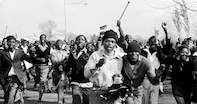
June 16th in Black and White
The day is 16 June 1976. In the lead-up to this day, a phenomenon has swept the land. Word has spread like invisible fire. The black youth guard a secret closely. Not even their teachers or parents know about the planned march.
The nation will be shocked this cold winter morning, as news leaks of the protest against inferior Bantu education and Afrikaans as the medium of instruction. It starts in Soweto, spreads to Alexandra, next to the then Pretoria (now Tshwane), and so its flames extend. When journalists are prohibited from entering Soweto, Dr Peter Magubane is on the scene, equipment loaded.
A soldier with a camera. In the distance he sees sinister black smoke, a signal of action on the ground. He moves between these sites. Dr Magubane has more photographs of 16 June than any other photographer. Black and white images of the schoolchildren fleeing from the hail of bullets intended to kill them.
Mixed emotions of terror and liberation saturate their faces. It is a powerful turning point in a land of oppression, forever recorded by Dr Magubane’s shutter.
Exposed: The Atrocities of Apartheid
On one occasion, while Dr Peter Magubane is covering the continuing uprising, the police assault the cameraman and break his nose. They tell him to expose his film to light, to destroy the images. Peter is more concerned about losing the images than his bloody face. The world needs to see the undeniable horror, the brutal madness of apartheid captured on film.
Later that year, when the police incite the Mzimhlophe Hostel dwellers to attack the township residents, Peter works into the night covering the violence.
As he passes his Diepkloof home on his way to the paper's offices he sees his home ablaze. He is powerless as he watches the building crackle to the earth. Again in August 1976, he is detained for 123 days with other black newsmen — another futile government attempt to prevent his work from exposing the atrocities of apartheid.
Photographs Record History
Sometimes Magubane's work steps on toes. When he does get threats, he says very firmly, 'I don't take threats!' He is a stubborn man, who is angered when he doesn't get his own way. Most people find themselves backing down to his authority. After all, he has gone up against the Nationalist government and prevailed. There's not much that can intimidate Peter Magubane.It is painful to bring up the past, but he does so graciously. 'Often in my work I would find a person struggling, even dying', but the photographs came first. 'It was only after, when I got home, that I would ask myself" what are you doing?".' But the next morning, it was back on the streets with camera in hand. He was driven by the belief that, 'The world will respond!'
 Soweto developed at the same time as Johannesburg, and for the same reason - gold. In 1885, the gold rush was in full swing, prospectors fro...
Soweto developed at the same time as Johannesburg, and for the same reason - gold. In 1885, the gold rush was in full swing, prospectors fro... They realised their parents, teachers and school boards had been unable to persuade the apartheid government to change its iniquitous policy...
They realised their parents, teachers and school boards had been unable to persuade the apartheid government to change its iniquitous policy...